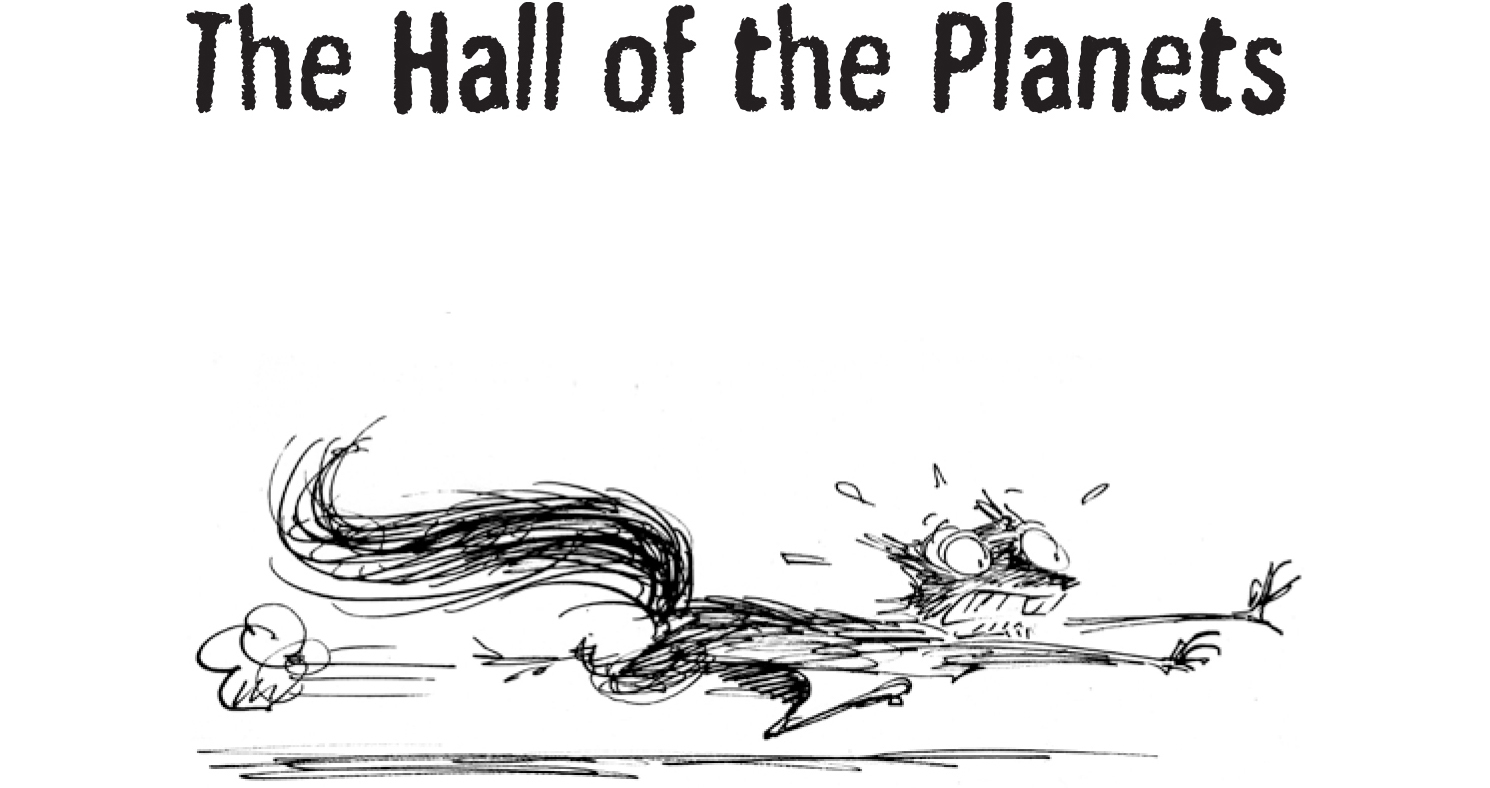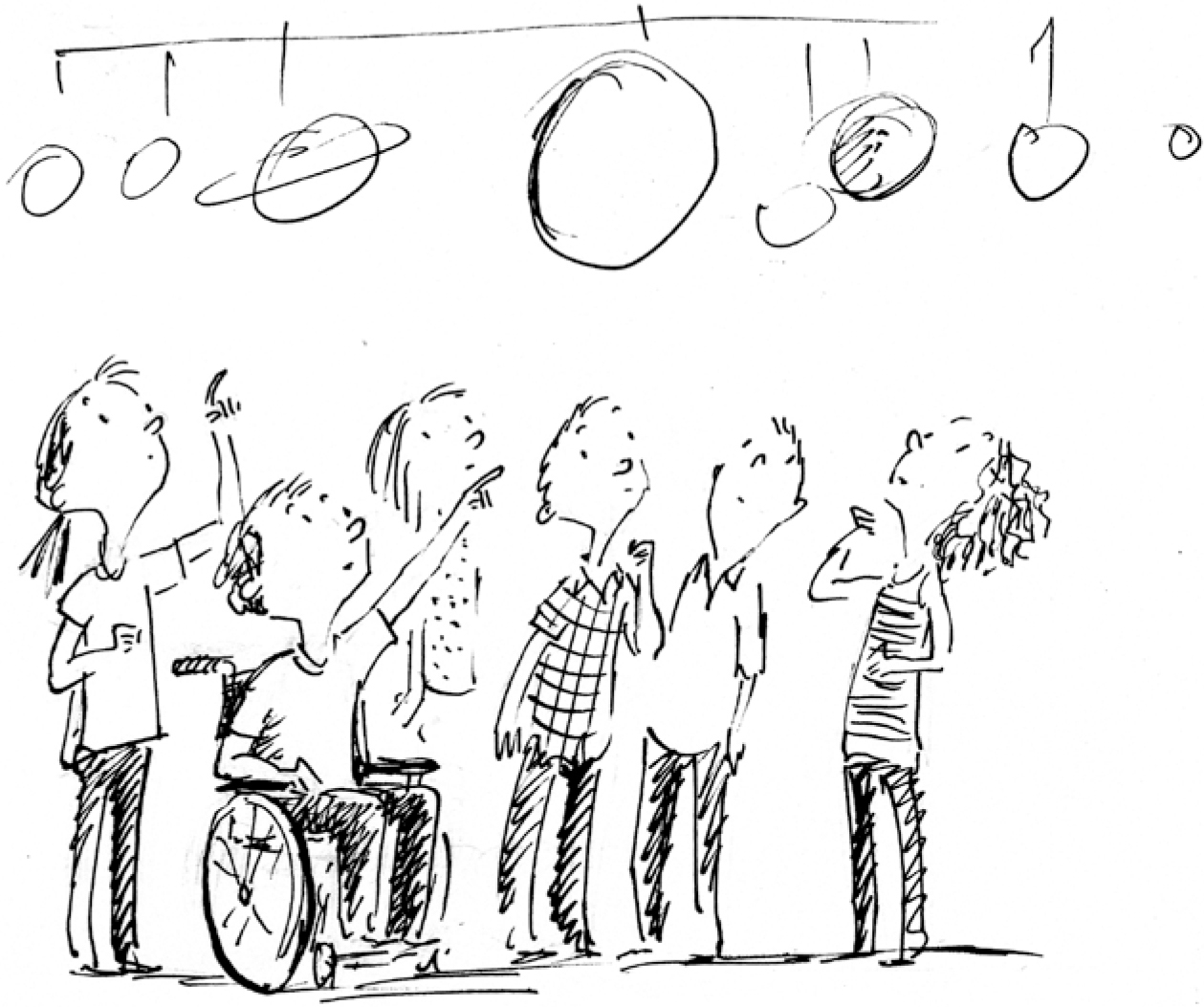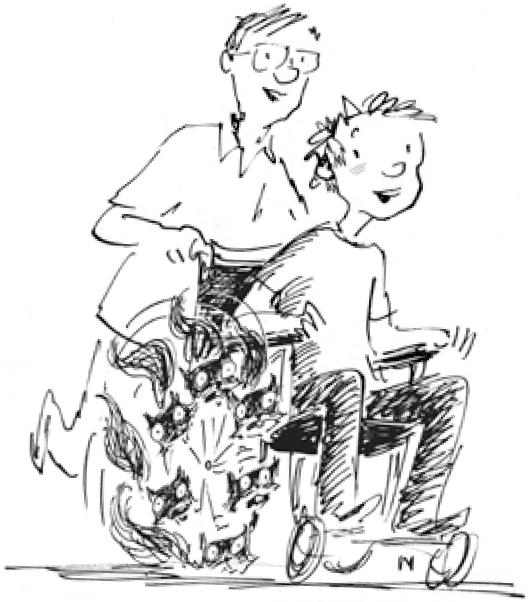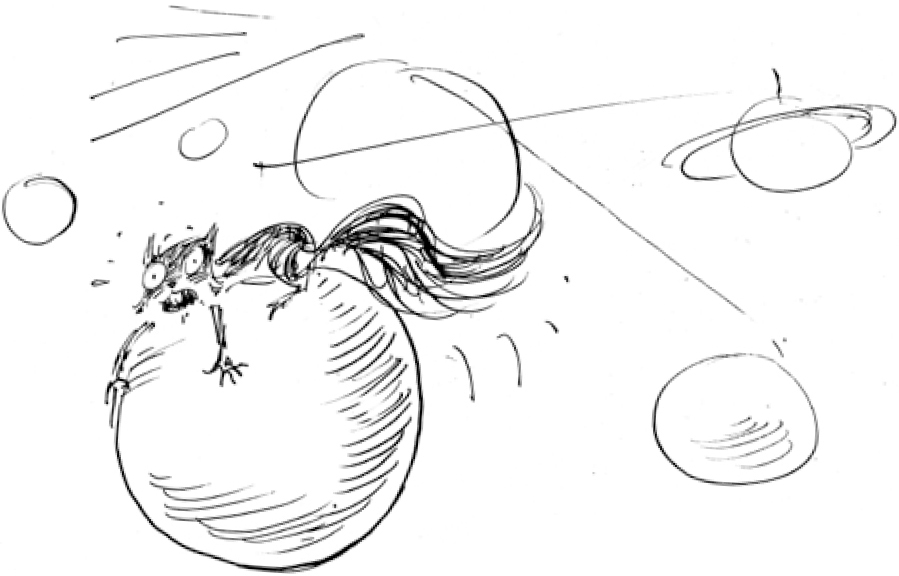
The next doorway leads to a room whose walls curve around in a circle. (I know my shapes from listening in at the school window of the first grade.) I recognize people from the field trip bus, but I don’t see the girl whose backpack I rode in.
Is she still by the dinosaur, screaming? I wonder. I listen but she must have stopped, for squirrels have excellent ears, and I’d be able to hear her, even from this other room.
This room is as dark as outside right after sunset. Those children and adults who are in here with me are moving slowly and looking upward. These two things are good because they mean nobody will be noticing me on the floor so no one will be trying to claim me as a pet. I just need to avoid their feet.
I dart left.
I dart right.
I dart around.
I dart between.

Once in a while, my tail brushes someone’s ankle, and they squeal, “What was that?”
But by the time they look, I have darted somewhere else.
But all that looking up they’re doing makes me curious, so I look up, too, to see what’s so interesting, just in case it’s something good, like fruits or nuts about to drop from above, or something bad, like an owl circling hungrily.
What I see are balls of various sizes and colors hanging from the ceiling.
The reason it’s so dark in here, especially near the floor, is because the only light comes from the biggest ball, which is glowing as it hangs there in the center. It is also the only one sitting still while the others move around it. The children reach up, stretching, but the balls are too high above for them to be able to touch.
The people at the museum may have planned this.
Even though there clearly is nothing about wolves here, I decide the dark makes it safe for me to stay for a little while to listen and learn—which is what the geckos told me to do. But I keep on darting: left, and right, and around, and between.
“So these are the planets,” a girl says, “which means that one must be the sun. So, is that the earth?” Her face is tipped upward to see the planets rather than forward to see where she’s going as she walks to keep up with a blue-and-green ball overhead. It’s about the size of an apple.
Teachers like to answer questions with questions, so I guess it is a teacher who answers, “Is it the third one from the sun?”

Another probably-teacher asks, “Is two-thirds of it covered by blue for water?”
From behind me, just coming in, is a voice I recognize as the voice of the boy with the movable chair. Maybe he hopes to be a teacher someday, for he too answers with a question: “Does it have a sign on the wall saying it’s the earth?”
The girl who asked leans against the handrail that goes along the entire circle of the wall. There are signs here and there on the wall, with little lights over them, and the girl peers at one of them. “Oh, they included the moon, too,” she says, but then she looks up to check.
I look up, too. There is what looks like a giant gray blueberry near the blue-and-green apple planet.
The boy in the chair says, “This isn’t right.”
I know what he means. We live on the earth. Obviously the earth isn’t round, or we’d fall off. The moon is round—except when it isn’t—but it’s not a blueberry.
The boy says, “This isn’t accurate. It isn’t to scale.”
The only scales I know are on snakes, so I don’t know what he’s talking about.
Neither does the teacher who is pushing the boy’s chair. “What do you mean?” the teacher asks.
The boy says, “The solar system is too immense to be shown to scale in any room. It would take more than three million earths to fill the sun. This sun, here, is about the size of a beach ball. That means the ball representing the earth should be just a little bit bigger than a pea, and Mercury would be the size of the head of a pin.”
“That would be hard to see,” one of the other children acknowledges. The planets stop moving, and he pushes a button on the wall, which gets them going around the room once more. “But if that’s the right way, that’s the way they should show it.”
I think so, too. The geckos said science is about facts.
The boy in the chair shakes his head, which—for people—means no even though for squirrels it means something’s gotten into my ear. The boy says, “But then the room would have to be about a mile and a half long.”
“Know-it-all,” someone says, in a tone that indicates that knowing all there is to know is a bad thing—even though it sounds like a good thing to me.
Someone else asks one of the teachers, “Is that true?”
The teacher says, “Ahmmm. Well. Ahhh. Don’t forget, I teach math, not science.”
“It is,” says the girl who is still by the sign on the wall that tells which planet is which. “It says so here, on this sign, under Facts. It says this display is to show the order the planets are in, and which are big ones and which are smaller ones. Ooo, and it says if you include Pluto, Pluto would be the size of a dot made by an extra-fine pen, and that it would be two miles away.”
“I don’t think they should have gotten rid of Pluto,” another child says.
Squirrels don’t have planets, but when most of the children call out their support for Pluto still being a planet, I agree with them because it isn’t nice to not include everyone.
They teach that—along with shapes—in first grade.
More children start to crowd around the girl to look at the Facts sign by her, even though there are plenty of other Facts signs around the room, and I get nervous that they are so intent on reading facts that one of them will step on me. Other people have come into the room, and nobody is leaving. There are just too many feet blocking my way to the door I came in, and there are even more feet between me and the second door, which leads farther into the museum—to where I will learn about wolves.
I dart left, right, around, between—and I’m no closer to a door than I was before.
So I climb up onto one of the big wheels of the boy’s movable chair.
Neither the boy nor the teacher notices me. But then the teacher says, “Well, why don’t we move on to the next exhibit and make room for others to see this? I hear they have pieces of meteorites and lunar rocks and a Mars rover model.” And with that he starts pushing the chair.
I’m holding on to the side of the wheel, not the rim, so I don’t get run over, but I go around once…twice…three times…and I’m getting dizzy.

When the spot where I’m holding on once more reaches its highest, I jump off the wheel and onto the boy’s lap, hoping he won’t notice.
But he does. He gives a squeal just as loud—but not as long—as the backpack girl did when I first climbed onto her head.
I jump from his lap to the handrail that keeps the children from actually touching the Facts signs. From there I jump onto one of the planets that’s overhead. Luckily, the one that happens to be closest to me is the biggest, so it’s easy to catch hold of even though it takes an expert jumper like me to make it.
The ball begins to swing back and forth even while it continues to move in a slow, steady trek around the room and the glowing ball in the center.
All of a sudden, nobody is interested in whether Pluto should still be a planet.
There’s a lot of gasping and squealing, and then people start shouting:
“It’s a squirrel!”
“It’s that squirrel that was on Lydia’s head!”
“It’s gotten onto Jupiter!”
The planets are moving at different rates of speed, but only Jupiter is swinging.
I jump onto another planet, and this one has a ledge around it, which makes my hold even steadier even though now it’s swinging, too.
Except that there’s a loud crack! and suddenly the ledge is tipping downward.
“There go the rings of Saturn!” someone shouts.
Some of the children duck and cover their heads and scramble to the edge of the room as though afraid I’ll lose my grip and fall on them. At the same time, others crowd in for a closer look.
“Let me through! I’ve got a net!” calls a voice I recognize as belonging to Security Guard.
A net doesn’t sound good.
But the boy in the movable chair cheers me on: “Squirrels in Space! You go, squirrel!”
My Saturn-ball is about as far away from the center of the room as its journey around the sun takes it, so I jump again before the ledge can break off entirely. Good thing I jump when I do: Saturn’s ledge breaks free of Saturn, Saturn breaks free of the string holding it, and both pieces hit Security Guard on his shiny head, one after the other.

“Ow! Ow!” he says.
The new ball I’m on is much smaller, but it’s the one that’s farthest away from the light in the center that’s meant to be the sun.
“Neptune!” the children sing out the way they do on oral quiz day.
Because Neptune is so small compared to the last two planets I was on—it’s a bright blue grapefruit—I need to curl myself around it, and its swinging is enough to make even a surefooted squirrel eager to move on. I see I’m approaching the door that leads farther into the museum.
And—since I’ve learned all there is to know about planets—I jump.